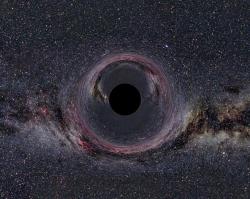 One of the mysteries that has puzzled physicists has to do with black holes. When information goes into a black hole, is it completely destroyed, or is it maintained in some form? Physicist Stephen Hawking believes that black holes will evaporate over long periods of time, slowly releasing featureless particles. Whatever information went into the black hole would then be destroyed.
One of the mysteries that has puzzled physicists has to do with black holes. When information goes into a black hole, is it completely destroyed, or is it maintained in some form? Physicist Stephen Hawking believes that black holes will evaporate over long periods of time, slowly releasing featureless particles. Whatever information went into the black hole would then be destroyed.
Continue reading “A Solution for the Black Hole Information Paradox?”
Our Supermassive Black Hole Is a Natural Particle Accelerator
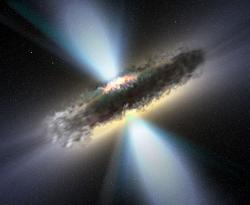 Although the centre of the Milky Way is obscured by gas and dust, you can see right through using wavelengths other than the visible spectrum. Infrared is great, but it can also be revealed in gamma rays. And here’s the strange thing, gamma rays are pouring out from the centre of our galaxy.
Although the centre of the Milky Way is obscured by gas and dust, you can see right through using wavelengths other than the visible spectrum. Infrared is great, but it can also be revealed in gamma rays. And here’s the strange thing, gamma rays are pouring out from the centre of our galaxy.
Continue reading “Our Supermassive Black Hole Is a Natural Particle Accelerator”
Podcast: Black Hole Questions Answered
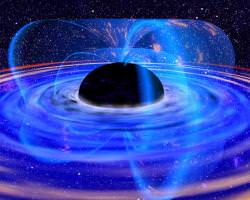 Our episode on black holes generated many many questions from listeners. We dip into this bottomless pool of questions and start dealing with them. Are really big black holes like the Big Bang? How can black holes evaporate? What would it look like to stand on a black hole? And just how large would a rock have to be before its gravity is so strong that a human can’t escape?
Our episode on black holes generated many many questions from listeners. We dip into this bottomless pool of questions and start dealing with them. Are really big black holes like the Big Bang? How can black holes evaporate? What would it look like to stand on a black hole? And just how large would a rock have to be before its gravity is so strong that a human can’t escape?
Continue reading “Podcast: Black Hole Questions Answered”
All Was Quiet in the Galactic Centre
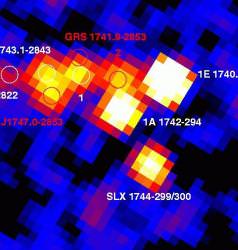 For a brief time in April 2006, the active region surrounding the supermassive black hole at the heart of the Milky Way settled down. Ten different sources of high energy rays all faded away temporarily, and ESA’s Integral probe was able to capture images of less bright regions, which weren’t completely obscured by the bright objects in their vicinity.
For a brief time in April 2006, the active region surrounding the supermassive black hole at the heart of the Milky Way settled down. Ten different sources of high energy rays all faded away temporarily, and ESA’s Integral probe was able to capture images of less bright regions, which weren’t completely obscured by the bright objects in their vicinity.
Continue reading “All Was Quiet in the Galactic Centre”
Light Echoes from Our Supermassive Black Hole
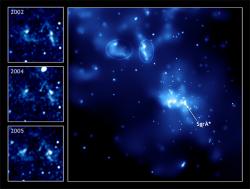 A new set of images from the Chandra X-Ray Observatory show the reflected X-ray emission from a small meal consumed by the supermassive black hole that lurks at the heart of the Milky Way.
A new set of images from the Chandra X-Ray Observatory show the reflected X-ray emission from a small meal consumed by the supermassive black hole that lurks at the heart of the Milky Way.
Continue reading “Light Echoes from Our Supermassive Black Hole”
First Triple Quasar Discovered
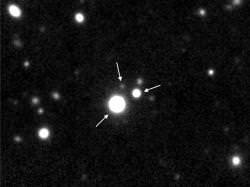 Quasars are some of the brightest objects in the Universe, beaming radiation across billions of light-years of space. Although they were a mystery for many years, astronomers now believe they’re the bright radiation from matter clogging up around an actively feeding supermassive black hole.
Quasars are some of the brightest objects in the Universe, beaming radiation across billions of light-years of space. Although they were a mystery for many years, astronomers now believe they’re the bright radiation from matter clogging up around an actively feeding supermassive black hole.
Continue reading “First Triple Quasar Discovered”
Even Dwarf Galaxies Have Supermassive Black Holes
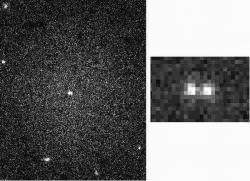 To form a supermassive black hole, you’d think it takes a really large galaxy, like the Milky Way or Andromeda. But it appears that these monsters can form at the heart of plain old dwarf galaxies too.
To form a supermassive black hole, you’d think it takes a really large galaxy, like the Milky Way or Andromeda. But it appears that these monsters can form at the heart of plain old dwarf galaxies too.
Continue reading “Even Dwarf Galaxies Have Supermassive Black Holes”
Podcast: Black Holes Big and Small
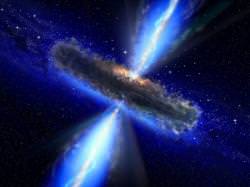 We’re finally ready to deal with the topic you’ve all been waiting for: Schwarzschild swirlers, Chandrasekhar crushers, ol’ matter manglers, sucking singularities… you might know them as blackholes. Join as as we examine how black holes form, what they consume, and just how massive they can get.
We’re finally ready to deal with the topic you’ve all been waiting for: Schwarzschild swirlers, Chandrasekhar crushers, ol’ matter manglers, sucking singularities… you might know them as blackholes. Join as as we examine how black holes form, what they consume, and just how massive they can get.
Continue reading “Podcast: Black Holes Big and Small”
Black Hole Found in a Globular Star Cluster
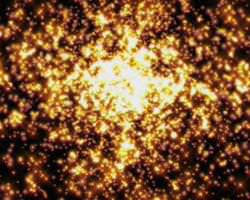 Stellar mass black holes have been discovered, and astronomers now believe that supermassive black holes exist at the centres of most galaxies. But now a black hole has been discovered inside a globular star cluster. This could be one of the elusive “intermediate-mass” black holes.
Stellar mass black holes have been discovered, and astronomers now believe that supermassive black holes exist at the centres of most galaxies. But now a black hole has been discovered inside a globular star cluster. This could be one of the elusive “intermediate-mass” black holes.
Continue reading “Black Hole Found in a Globular Star Cluster”
Here’s a New Way to Explode: Hybrid Gamma-Ray Burst
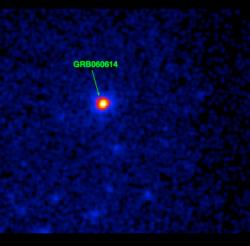 Just when you thought you’d figured out all the ways to blow up, nature reveals a new way. This latest class of explosion is called a hybrid gamma-ray burst, and it was discovered by NASA’s Swift satellite. As with most gamma-ray bursts, this explosion probably indicates the birth of a new black hole in the Universe; however, the explosion itself was different from what astronomers have seen before.
Just when you thought you’d figured out all the ways to blow up, nature reveals a new way. This latest class of explosion is called a hybrid gamma-ray burst, and it was discovered by NASA’s Swift satellite. As with most gamma-ray bursts, this explosion probably indicates the birth of a new black hole in the Universe; however, the explosion itself was different from what astronomers have seen before.
Continue reading “Here’s a New Way to Explode: Hybrid Gamma-Ray Burst”
